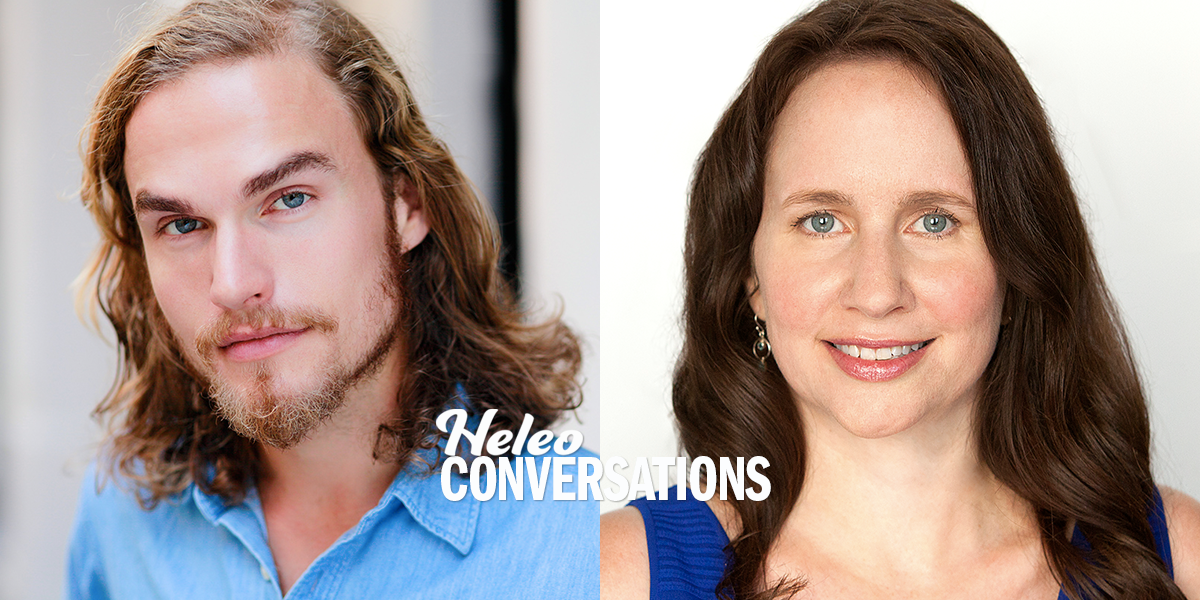Drake Baer, a senior science writer for New York Magazine and co-author of Everything Connects, recently sat down with Columbia University Professor of Social Psychology, Heidi Grant. Grant is a social psychologist and the author of No One Understands You And What To Do About It and Nine Things Successful People Do Differently. They spoke about what we get wrong about communicating our intentions and how to improve body language.
Drake Baer: I have found in my own very awkward social life that there is indeed a gap between how I perceive myself and how other people perceive me. What’s going on there?
Heidi Grant: There are really two things going on. One is that, to some extent, we are strangers to ourselves. We don’t often know ourselves as well as we think we do. This is the great irony. We all walk around every day, trying to make sense of other people’s behavior, but the vast majority of what goes into how we interpret another person’s behavior is stuff we don’t even realize we’re doing. Because we don’t know how it works, we then lack insight to how our own behaviors come across to other people.
There’s a phenomenon called the illusion of transparency that basically all humans are subject to. We think we’re much more of an open book than we actually are. When really we need to recognize that if we put in a little more effort and be a little bit more deliberate about the signal we send, then we can help people more easily understand us.
Drake: A few weeks ago I interviewed a relationship psychologist who does marriage counseling. I forced him to to boil down his advice to one point. He said the best thing you can do is to be able to express your interior state in such a way that your partner can empathize, because if you don’t put it into words then all they have is your behavior.
When a behavior is ambiguous, if anything we tend to interpret it in a slightly negative way.
Heidi: Something like, “I’m just going to go off and be by myself for awhile” has so many possible interpretations. And the perceivers themselves aren’t a blank slate either. They’re trying to figure out why you’re retreating, why you’re being aloof. Maybe they have their own insecurities or things that are going on and then those things combine and ignite in a counterproductive way. When a behavior is ambiguous, if anything we tend to interpret it in a slightly negative way.
If that behavior has an interpretation that is possibly rejecting, like, “Oh, you know when I was talking during the meeting, you weren’t looking at me, you were looking off at the wall,” I’m going to be tempted to think it’s rejection. Even though there may be a lot of good reasons why you were doing that.
It’s not just that people are wrong. They tend to be wrong and interpret it negatively. David Funder is a psychologist who studies perception and he’s been particularly interested in what he calls “good targets.” These are people who are more readily understood by other people. One of the things that’s true of good targets is that they do a lot more expressing. They have more emotional fluency, they are better at talking about what’s happening inside of them so that other people understand it, but they also are most likely to explicitly say what their intentions are in a situation, to talk out loud about what they’re thinking.
That’s hard for a lot of people. If you’re an introvert or you’re a bit shy, you have more of an avoid attachment style so you’re not really interested in being vulnerable with other people. All of those things increase the chances that you won’t be understood by the people around you because you’re not giving them that much information to go off of.
Trending: Navy SEAL Secrets for High Performance Under Pressure
Drake: There’s all this fascinating research about the beauty gap, that the differences in attractiveness predict income differences in the same way that gender and ethnicity do. How do our appearances inform the stories that people tell themselves about us?
Heidi: When you’re looking at somebody your brain immediately begins to try to process them, to make an informative impression of them so that you know how to interact. The very first thing we have in terms of pieces of information are appearance pieces, like how attractive a person is or what they’re wearing.
Of course, there are also things like gender and race that we notice immediately. For better or worse, each of those pieces of your appearance are activating different kinds of stereotypes. One of the most fascinating and simultaneously terrifying things that psychologists have learned in the past 30 years of understanding stereotyping is that you don’t have to believe a stereotype to be affected by it. You just have to know what it is.
There are people who work very hard to not have their perceptions impacted by stereotypes but that process is fairly effortful. What happens automatically is that I see you and all of the stereotypes that I might associate with your appearance start activating in my mind. Very often they’re being applied to people for whom that stereotype should not apply at all, and it’s influencing again how you interpret those ambiguous pieces of information.
There are horrifying aspects of that. For example, if you show participants in a study very quickly an image of a man who’s either black or white holding an object and then you ask them later whether or not that object was a gun, they are much more likely to think that it was a gun if it was in the hands of a black man than if it was in the hands of a white man.
There are a lot of things that happen when stereotypes get activated that are just awful, and there are some things that are just sort of innocuous. The stereotype that we tend to have about beautiful people, that they’re more fabulous in general, is also called the halo effect. When people have one good quality, we often assume that they have a bunch of other good ones even though those qualities are unrelated. So even if in real life there’s no correlation between how attractive you are and how intelligent you are, we tend to assume that more attractive people are smarter and more honest and funnier and a whole bunch of other things that have nothing to do with each other.
The opposite of that is the horns effect: if you perceive a person to be quite negative in some dimension, that can also seep into other dimensions. An unattractive person can therefore be seen are more dishonest and unintelligent. I know you’ve written about those beautiful people who have it made because they have all of this bias in their favor. For the most part that’s true, although there are a few interesting exceptions to that, particularly for women. There can be instances, for example, in hiring where more attractive women are not hired for a position if they’re being evaluated by another woman. The person doing the evaluating is threatened by them.
Again, no one in a million years would think they hired someone that they thought was smarter because they were better looking. You would laugh if someone accused you of that — but it’s probably happening.
Research suggest that about 85 to 90 percent of your impression of another person is accounted for by two things: competence and warmth.
Drake: When you’re meeting someone for the first time, what do you call to mind from your vast inventory of insight?
Heidi: Research suggests that about 85 to 90 percent of your impression of another person is accounted for by two things: competence and warmth.
In general, people are aware that competence matters. We want to look like we’re smart and capable and know things, so we do things on purpose to make sure that we come across as competent.
Unfortunately, people don’t seem as aware that warmth is really important and they don’t know when they’re not doing it. They just assume that they come across as warm even if they come across as quite cold.
Trending: How to Make Menopause the Best Time of Your Life
There are two very concrete things you could do to come across as warm. You’re told all the time that eye contact is important, to look at people, but usually the way that advice is given is that you should look at people when you’re talking, because that’s competence. If I’m looking at you when I’m talking to you, that means I know what I’m doing. Actually looking at people when they’re talking is a really strong signal of warmth.
If you’ve ever been in a conversation with someone who doesn’t nod back when you’re talking, it’s unnerving. They just stare and all of a sudden you’re like, “Are they understanding me? Have I offended them?” You start having this weird anxiety, sometimes you don’t even know why. It’s because the nod is both a signal of understanding and it’s a little affirmation. You don’t want to do it constantly but it’s a really important signal. Smiling at people who smile at you — a lot of basic social stuff isn’t basic to a lot of people.
There’s a thing psychologists study called the superfluous apology. A real apology is, “I did something to you and I stepped on your foot and I’m sorry.” A superfluous apology is, “Oh, you’re really tired from this weekend that you were at the shore? I’m sorry.” I’m not actually apologizing, because I didn’t make you tired, but I’m expressing empathy. When someone says that something bad happened to them and you say, “Oh, I’m sorry, that’s terrible,” sometimes that little thing is really powerful. Often when someone tells us something bad happened to them, we don’t say anything and that can come across as really cold.
Drake: That reminds me, there’s a great profile by Ezra Klein from Vox about Hillary Clinton and why there’s this gap between the public Hillary and the Hillary that people know personally. She doesn’t play well in front of large audiences but, person to person, she inspires tremendously. One of the points that came up again and again in this profile is that Hillary is an expert listener. When she’s meeting with some policy expert she’ll bring up some obscure point about their recommendation to them and then she’s made their entire year.
We all want that feeling of being intensely listened to. When people do that for us, we like them so much.
Heidi: Right, it indicates that she cared, she was interested. It’s very affirming. Bill is a really good listener too, but he was also really good at looking like he was listening. Bill could do that intense face and people always said it made them feel they were the only person in the world. It’s an underrated skill. Just today, I was re-watching this clip of Mr. Rogers being interviewed by Charlie Rose, and he said one of the best things you can do for a child is to make them feel like you’re talking just to them and you’re focused on them. That makes them feel special and unique, as an adult taking that moment with them to really listen. It occurred to me that it’s just as true with adults. We all want that feeling of being intensely listened to. When people do that for us, we like them so much. And being a good listener makes you look smart, because people infer that you’re really intelligent because you were listening so much to what they were saying.
That particular thing that Hillary does person-to-person doesn’t translate to the stage. If you’re in front of a room or at the front of a meeting, you want to be sending those warmth signals. You want to be making people feel valued, that you’re not just up there being cold and competent, which is the worst combination. It’s very, very hard to do with a group because you can’t do the thing where you listen to everyone individually, connecting and nodding when they’re talking.
People tend to be very loyal to managers and leaders that make them feel like they’re paying attention to them individually. I know you’ve written about power too and one of the great ironies there is the more powerful a person is, typically the worse they get at doing this. It really is an effect of power much more than it is about the kind of people who seek power. Studies show that any of us, once put into a position of power, can become less thoughtful about the people around us, pay less attention to the people that work for us. And so for anybody rising up in an organization, you need to think, “How can I deliberately make sure this doesn’t happen?”
You have to stop and be deliberate. If you just run on autopilot and take all the shortcuts, you’ll be efficient but you’ll have tons of problems in your personal interactions with other people. Put the brakes on, be a little thoughtful, meditate a little bit — you’ll have a much greater chance of success.
And again, come across the way you mean to. With the book, I didn’t want to teach anybody how to fake being these things, I operated under the assumption that most people actually do care about the people around them, do mean to come across as warm, do mean to be good eggs and they just aren’t managing it, and they don’t know why.
[Questions from the Audience]
Trending: Microsoft, Google, and Beyond: What Business at the Cutting-Edge of AI Looks Like
Viewer: How do you deliver information to others that might be perceived as unfavorable or disruptive without damaging your relationship with the receiver of the message?
Heidi: It’s never a bad thing to start with a little bit of reassurance. Don’t give the feedback sandwich — that’s ridiculous. Positive, negative, positive doesn’t solve any problems unless you’re doing it right. What matters is the kind of thing that you’re saying. It can help to start by giving the person the context of why you’re saying it.
In the context of work, for example, if you want to talk about something, start with saying that you really like the job that they’re doing and you think they’re great and the reason you’re telling them this is because you think it’s something useful to them to help them grow. Give them a little bit of reassurance that you think that they’ll benefit from hearing this. That works in personal relationships too, “I appreciate that you’ve done X,Y, and Z, I want to talk to you about this other thing because it’s troubling me and I know that you don’t mean to do that.”
I think that a lot of conflict happens when you just go to the criticism. Immediately the person’s mind goes to the relationship, whether it’s a work relationship or a personal one. The relationship is in jeopardy.
Drake: Catastrophizing.
Heidi: Completely catastrophizing. It blows it out of proportion and it becomes a global thing instead of a specific thing. If you start by giving the reassurance and the context and the assurance that the relationship is good, then people are much more open to hearing whatever it is that you have to say.
Drake: Then the framing goes from one of conflict to one of cooperation.
Heidi: You can set that tone by starting with the reassurance and then offering the criticism, but not in a defensive way. Say, “What do you think about it, what is your view of that?” and invite them to have a view, too. It should feel like a conversation between two people that care about each other.
This conversation originally appeared on Facebook Live. It has been edited and condensed.



























